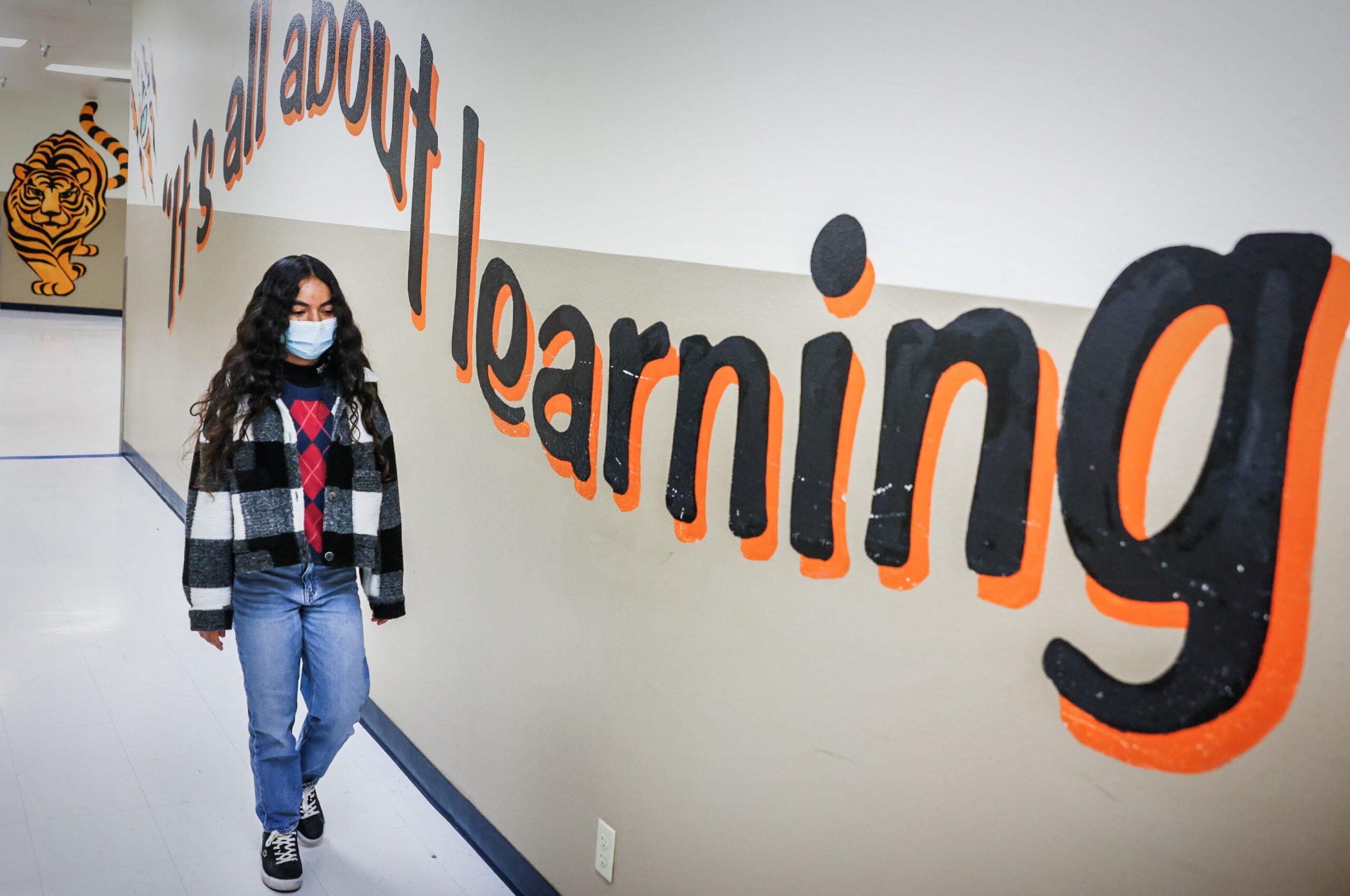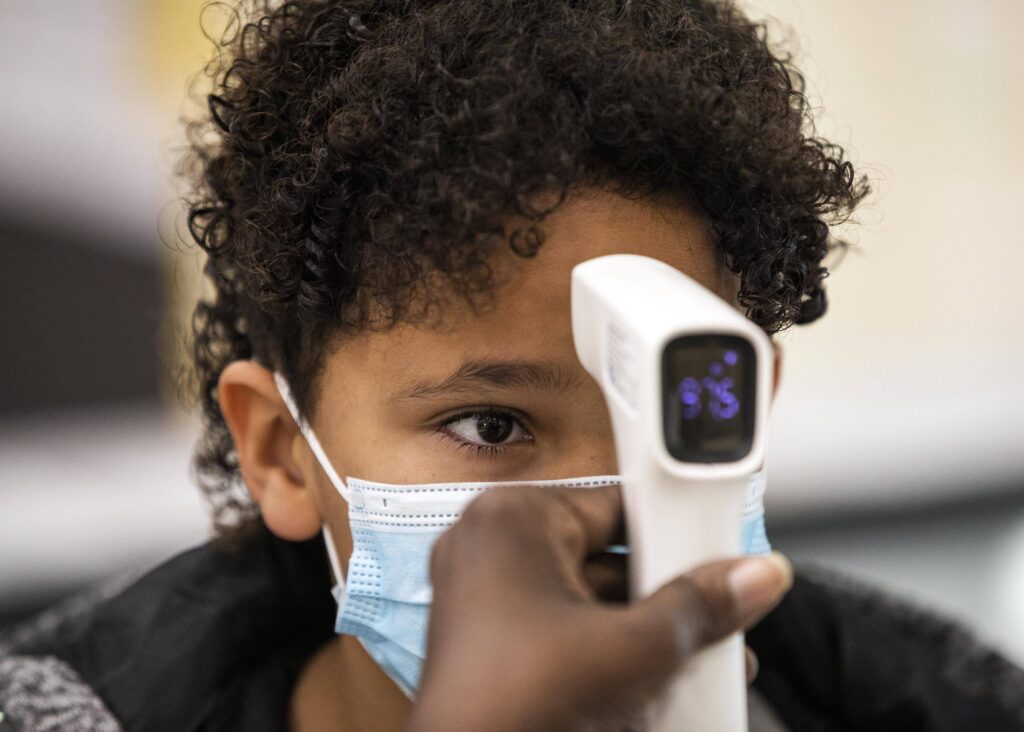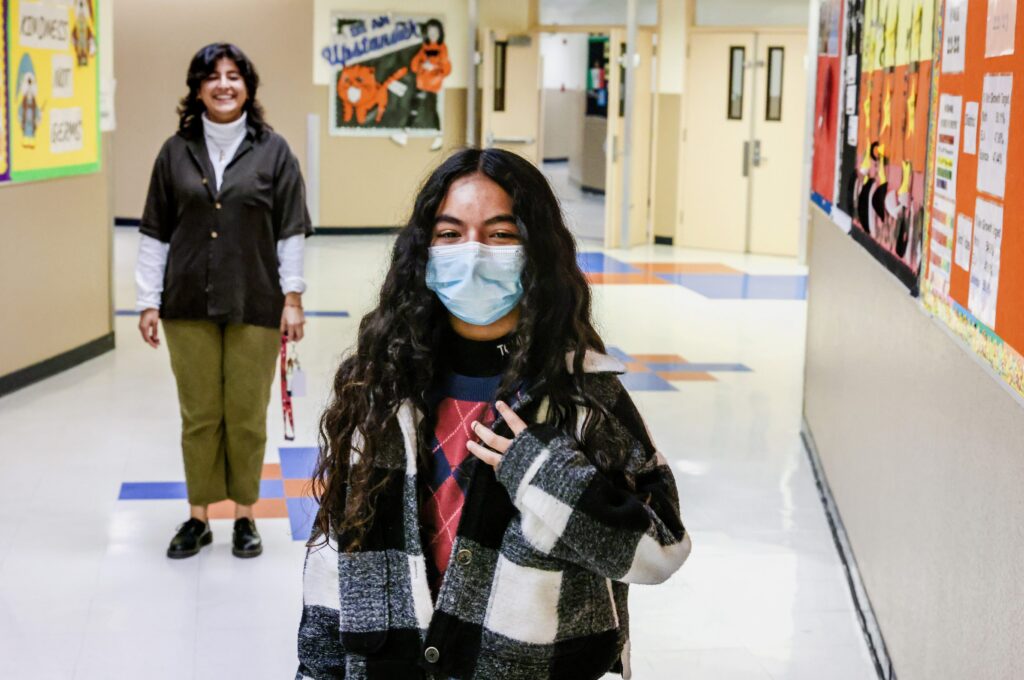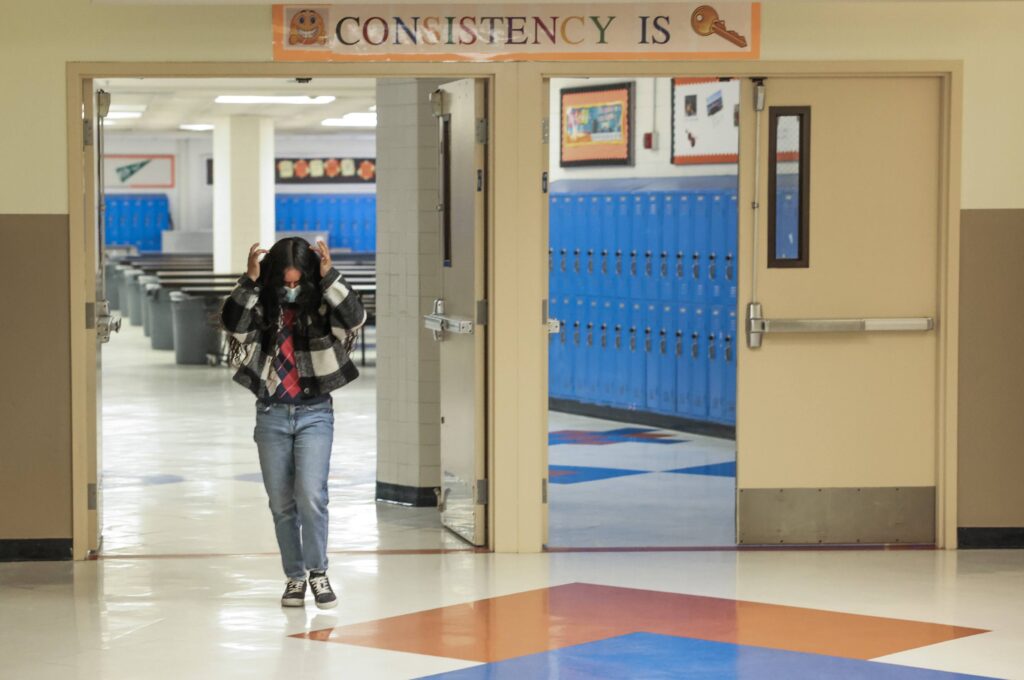From face masks to tutors and bonuses, districts show how they spent wave of federal aid

Art is seventh grade student Ziva Cruz’s favorite class at Von Tobel Middle School in Las Vegas — history and science, not so much.
The 12-year-old struggles in those subjects, in part because she’s still learning English. But Ziva has seen her grades improve since receiving support from the Communities in Schools (CIS) nonprofit organization focused on helping students reach graduation.
Von Tobel is one of 11 Clark County schools that CIS was able to expand to this year thanks to support from a portion of the district’s federal COVID relief funding. CIS, which has a local network of 65 schools, also used the funds to add more staff.
“It's allowing us to cast the net wide, but also deep,” said CIS Executive Director Tammi Hance-Lehr. “We know that if we can put a site coordinator on campus, magic will happen and barriers will be removed.”
That’s been the case for Ziva. She’s been working with Von Tobel site coordinator Karina Torres to catch up on her school work and get back on track. Torres also has advocated for Ziva’s teachers to let Ziva turn in assignments in Spanish to keep her from falling further behind as she works on improving her English skills.
“I don’t feel as much pressure now with my assignments,” Ziva said in a Spanish interview, adding that she no longer fears getting scolded for late assignments or being held back.
CIS’s expansion at Von Tobel is just one example of how school districts and charters used the more than $1.6 billion in federal COVID relief aid that Nevada received since March 2020 — across three separate funding packages — to get students and staff through the pandemic and move beyond it.
Ninety percent of the funds from each of the Elementary and Secondary School Emergency Relief Fund (ESSER) packages went directly to districts and charter schools. The rest, about $166.7 million, was set aside for the Nevada Department of Education (NDE) to distribute in the form of grants.
A new website by NDE shows how school officials statewide invested the historic amount of funding to help students and staff navigate the pandemic.
Clark County School District received the lion’s share of those funds, $1.2 billion, followed by Washoe County School District with almost $123 million and the State Public Charter School Authority at nearly $83 million, which was distributed among its 73 sponsored charter schools.
Eureka County School District was ineligible to receive ESSER funds because the money only went to districts and charter schools that receive and accept federal Title I funds to support students from low-income households. Though more than one-fourth of the district’s nearly 350 students receive free or reduced-priced lunch, Eureka declines those funds.
Superintendent Tate Else didn’t specify how much his district could receive in Title I funds, but said the amount was not sufficient enough for Eureka to implement all the reporting and accountability that’s required.
“The website gives us all of that transparency, and what we know is that our individual school districts have different needs,” said State Superintendent of Public Instruction Jhone Ebert. “The school superintendents, state boards of education are all required to align their funds to meet the needs of their individual students.”
In a state that has traditionally ranked low for its per-pupil funding, the infusion of one-time funds allowed school districts and charter schools to support positions and programs that they otherwise wouldn’t have been able to afford. But with school officials expected to use up the final round of ESSER funds by September 2024, questions remain on what will happen to those services afterward.
Getting through COVID
According to NDE’s online tracker, as of early February, half of the $1.5 billion in ESSER funds that went to districts and charter schools has been spent and expensed, meaning the district has paid for a good or service and has been reimbursed by the state.
More than 40 percent has been invested into staff, including paying incentives to retain educators who were overwhelmed and overworked during the pandemic and recruiting new staff to better support students and reduce class sizes.
An additional 37 percent was dedicated to instructional supplies, such as textbooks and online learning resources. NDE notes that its estimates on how much has been spent or expensed may lag what districts and charter schools have spent because the site only reflects what has been reimbursed by the state.
In the early days of the pandemic, two of the largest priorities included acquiring personal protective equipment to curb the spread of COVID in schools and technology to keep learning going when in-person instruction was limited.

Clark County schools, for example, have spent at least $16 million of their ESSER dollars to date on personal protective equipment, such as face masks, gloves and sanitation wipes. The district spent $40 million more from its ESSER II funds for technology supplies, including laptops and iPads.
As the pandemic continued, it exacerbated many of the other issues that schools were already struggling with — chief among them staff shortages. Districts including Carson City and Clark and Washoe counties were in dire need of bus drivers.
This problem forced the Washoe County School District to scale back transportation services while it worked to attract new bus drivers and retain existing staff. The tracker shows the district allocated almost $26 million in ESSER funds for additional compensation and incentives for existing classified staff among positions with severe shortages as well as to offer incentives for new hires and referrals in those areas.
Joe Ernst, the district’s chief accountability officer, said the efforts were successful.
“We've seen additional bus drivers, and over the past year, been able to now offer full service for all of our students,” Ernst said.
Districts and charter schools similarly have used one-time bonuses ranging from $2,500 to $5,000 as incentives to keep existing teachers. The Clark County School District spent almost $37 million of its American Rescue Plan (ARP) ESSER III funds on retention incentives for its more than 18,000 licensed employees, including teachers. Last year, the Washoe County School District spent more than $6.3 million of its ARP ESSER funds and an additional $4.3 million from its general fund on incentives for its 4,204 certified staff, including teachers.
Though the incentives helped districts close some gaps, retention issues statewide persist. The Nevada State Education Association (NSEA), the statewide teachers union, estimated there were almost 3,000 vacant certified and classified positions before the start of the 2022-23 school year. NSEA said the one-time bonuses were too short-term to make a long-term impact.
“The current shortage continues to be the result of low pay and an increasingly stressful work environment, neither of which were truly addressed by the one-time bonus,” NSEA said in a statement. “That is why NSEA has been calling for a 20 (percent) salary increase for educators and a $20 minimum wage in our schools.”
The Clark County School District started its school year with 1,340 classroom vacancies, even after it raised its starting salary for teachers to about $50,000, but the district said it’s since been able to bring that number down to fewer than 73 vacancies and has 99 percent of its teacher positions filled.
“With the increased starting salary for first-year teachers, CCSD is confident the District will continue to be an attractive option for teachers graduating college this spring,” the district said in an emailed statement.
Another funding priority was supporting students who fell behind academically during the pandemic. The Carson City School District, for example, tapped into its ESSER funds to offer summer school, which is not covered by the state. Superintendent Andrew Feuling said attendance was hampered by the district's inability to offer transportation because of the bus driver shortage.
“The fact that we were able to do what we did I'm really happy for, and I'm glad we were able to serve those families and kids. But it didn't exactly work out due to some of these troubles we're seeing with labor and the economy,” Feuling said.
Federal COVID relief funds also enabled school districts to do more creative things they couldn’t normally do. The Lyon County School District, with about 9,000 students, received $17.8 million in ESSER funds. The district used about $43,000 of its ESSER II funding to purchase supplies for a cafe where students with disabilities could learn job and business skills.
“So students are learning the entire process of buying the beans, roasting them … and then packaging, selling,” Lyon County schools Superintendent Wayne Workman said.
The Lander County School District, which serves about 1,000 students, was more limited in what it could do with the $1.4 million it received from the ESSER packages and instead focused on basic needs, Superintendent Russ Klein said.
“We had our ventilation system done, we've had video cameras put in for school safety, we've added additional instructional aides into the classroom and we've upped our summer school a bunch,” he said.
Nevada State Public Charter School Authority Executive Director Rebecca Feiden said in general, she’s seen charter schools spend a majority of ESSER funds on staff, including salary incentives, as well as innovative approaches to help students recover socially, emotionally and academically.
“We've seen everything from additional mental health and social worker support to instructional staff that are doing interventions to additional pay for existing staff to do Saturday school or after school, " she said, adding that charters have also heavily invested in teachers’ aides to lower student-to-teacher ratios and have more staff at school sites.
This was the case for Mater Academy of Nevada, which serves about 4,000 students, a majority of whom are learning English as a second language, across its three school sites in East Las Vegas. The school received close to $6 million in total from the ESSER packages.
Jenny Price, the organization’s grants manager, said after investing in COVID mitigation efforts, a majority of Mater’s remaining ESSER funds have been used to boost staffing to bring down class sizes and address learning loss, chronic absenteeism and social and emotional needs.
“We were also able to hire employees to work with our communities to provide additional support and resources for our [English learner] and disadvantaged families impacted by COVID-19,” she said.
Unlike school districts, public charter schools also received $31 million in loans from the Paycheck Protection Program. Some of the biggest winners included Coral Academy of Science Las Vegas and Doral Academy of Nevada, which each received PPP loans from $2 million to $5 million. The state charter school authority was not required to track which charter schools received the funds or how they were used, Feiden said.

Overcoming hurdles
Spending the ESSER funds hasn’t been as easy as some might think, Ebert said. Early on in the pandemic, she said supply chain issues made it hard for districts and charters to order supplies, such as laptops.
Ebert said a number of districts and charter schools had planned to use some of their funds to hire tutors, school psychologists and counselors but later found they couldn’t because they didn’t get enough applicants to fill the positions.
“So what the school districts have done is taken those funds that were allocated for people and have had to shift them to other supports for students,” Ebert said.
Ebert said some school districts have had to rely on outside sources for services, such as tutoring.
The Clark County School District, for example, paid nearly $13 million in ESSER funds to provide students access to the Paper online tutoring service through fiscal year 2024. Washoe County School District paid $2.3 million for a two-year Paper contract and the Elko County School District paid $375,000.
The Clark County School District also has partnered with local organizations such as CIS to provide more support and wraparound services beyond what the district can offer.
Torres said she has observed a great need for support since arriving at Von Tobel Middle School. All of Von Tobel’s 1,000 students qualify for free or reduced-price lunch, a common factor found in the schools that CIS serves. More than 80 percent identify as Hispanic, according to NDE data. Close to 30 percent are learning English as a second language.
As a Clark County school graduate born of Mexican parents, Torres said she can relate to many of the families she works with at Von Tobel.
“I come from a very strong Hispanic household so I understand their struggles, and being able to guide them and help them really, really makes just my day,” she said.
All Von Tobel students get access to CIS’s schoolwide services such as its resource room stocked with snacks, school supplies and clothing as well as a separate food pantry. Torres said the organization also helps struggling families with bill assistance and other needs. Torres offers more targeted programs or individualized support to students such as Ziva who need the help.
Torres is working with Von Tobel’s counselors and other partner organizations such as Boys Town Nevada to lower the school’s chronic absenteeism rate of 50 percent. Students are offered rewards such as free food, which she said is an effective motivator for middle schoolers, or other resources, such as free bus passes.

Looking beyond COVID
Districts and charters were required to spend or obligate all of their ESSER I funds by last September. They have until this September to spend or obligate their ESSER II funds and another year to do the same with their APR ESSER funds.
As those deadlines approach, one looming question is what will happen with all the programs, positions and technology that schools have invested in when the funding runs out.
Ebert said since Nevada began receiving ESSER funds two years ago, she’s recommended school officials figure out if they can keep initiatives they want to invest in going beyond 2024 or make plans to gradually phase them out.
The Clark County School District has been adamant about investing its ARP ESSER funds in resources such as curriculum and technology that can outlive the federal dollars, said Chief Strategy Officer Kellie Kowal-Paul.
“We believe that the student curriculum is important – one of the three pieces of student achievement is the curriculum that their teachers are teaching from,” Kowal-Paul said. “We want to make sure that the materials that teachers have are appropriate, grade level [and] high quality.”
Ebert and other school leaders are optimistic that some of the programs and positions funded with ESSER dollars can be extended as state lawmakers are looking to increase K-12 education funding by $2 billion as part of Gov. Joe Lombardo’s recommended budget over the next biennium.
“One of the great things about the Pupil-Centered Funding Plan is that the dollars are flexible at the local level, that they can invest in those areas where they see the most need,” Ebert said.
The Clark County district and its schools plan to assess which programs they want to keep going, and in schools’ cases, determine if they absorb those costs in their budgets. Kowal-Powal said schools may even be able to pay for the ESSER initiatives they want to keep using “carryover funds,” or dollars they carry forward from one budget year to the next, sometimes because they have trouble filling staff positions.
“So it's going to be decision making on the district end, but also at each individual school for these school leaders and their school communities to figure out which ones of these things are most impactful for that school community and how can we continue to pay for it out of our school funds,” Kowal-Paul said.
CIS officials are also hopeful the services they’ve added in Clark County schools will outlive the ESSER funds with the help of the additional K-12 state funding, grants and its philanthropic base so students like Ziva can continue getting the support they need to meet their academic goals.
“It's not an option that students at Von Tobel will not have a Communities in Schools when this money runs out,” Hance-Lehr said.
The Nevada Independent invites readers to share their thoughts on how schools are using ESSER funds, or ideas about other initiatives they’d like to see covered. You can send those comments to reporter Rocio Hernandez at [email protected].
